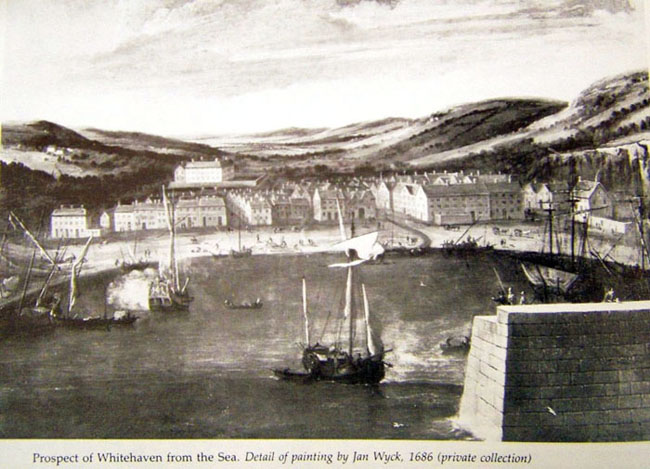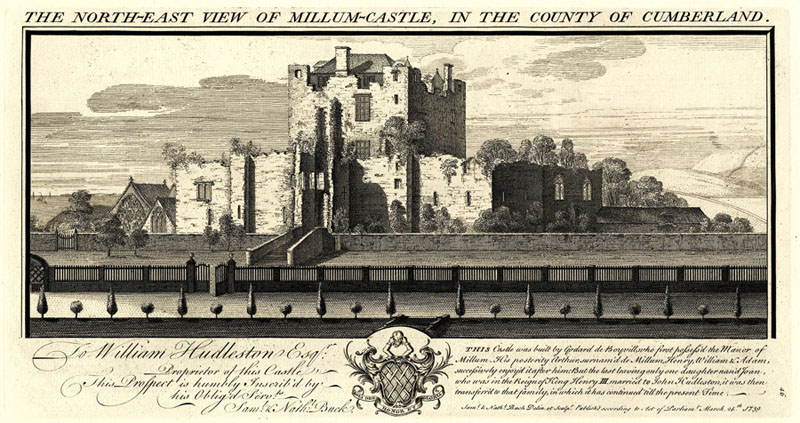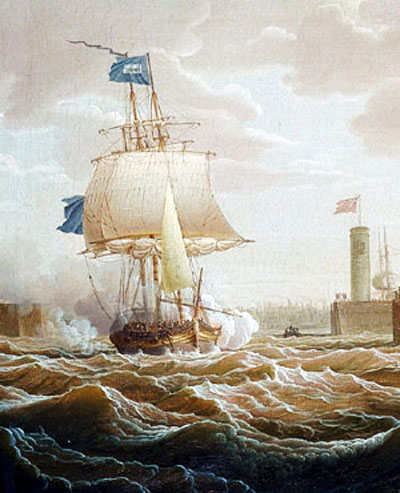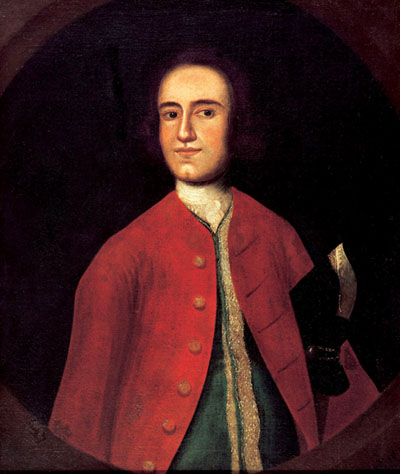Milam Mariners and Merchants from Great Britain
In the search for our Milam origins, the Milam shipmasters and Virginia merchants of Great Britain were an enticing possibility for exploration. These men primarily came from the Port of Bristol on the River Severn in southwest England and the growing Port of Whitehaven on the Irish Sea in northwest England. By 1750 Whitehaven was second only to the Port of London as the largest importer of colonial tobacco. Most of it was then exported to Ireland, Holland and France.
Milam Mariners of Bristol, England
John Mylam of Bristol was Shipmaster of the sailing vessel John and made three voyages to the Virginia Port of York in 1699, 1700 and 1701. [1, 2] The Royal Navy Shipping Lists for York describe the John as a square stern ship of 60 tons. Its arrival cargo were “European goods” and departing cargo was tobacco. There was no mention of passengers.
It may have been his death in Virginia which was administered in the Church of England's Prerogative Court of Canterbury, London in December 1701. American Wills and Administrations in the Prerogative Court of Canterbury, 1610 – 1857 states in part:
"Milam, John, of Bristol, who died in Virginia. Administration to Dorothy, wife of Richard Dyer, aunt and guardian of the children, John and Elizabeth Milam". [3]
In 1711, a passenger, John Mylam, sailed from Bristol to Virginia on the galley Cranfield. [5] There are no records for its arrival in Virginia since the Royal Navy Shipping Lists for Virginia from 1708 through 1724 are missing. Thus I was not able to learn which Virginia port the Cranfield entered. It is not know if this John Mylam was a merchant and returned to England or settled in the colony. But I reviewed the abstracts of court records for the counties of eastern Virginia and there is no record for this John Mylam. So it appears he didn't remain here.
Millam Mariners and Merchants of Whitehaven, England
Whitehaven was then in Cumberland County of far northwest England on the Irish Sea, rather isolated from the rest of England by mountains. The County was separated from Scotland by the wide Solway Firth and on a clear day one can see the Isle of Mann some 20 miles off shore.
 |
A few years ago when I was researching the earliest Milam, Millam, Mileham births in England, I discovered many in Cumberland County beginning with Edmundi Millam born to Johnis Millam on 21 FEB 1539 in St Bees Parish, Whitehaven. I placed all the early births on maps by time period i.e. 1530 - 1575, 1576 - 1600, etc. which you may view here (link) .
England had coal and Ireland did not so early shipping was the transport of coal to Ireland and the import of Irish goods. With Britain's growing Colonies in America needing more goods, the first Whitehaven mariners ventured to trade with Virginia in 1675. [715]
Sailing from Whitehaven had two advantages: 1) they could avoid the Dutch and French pirates and privateers who waited in the English Channel by sailing north around Ireland and 2) the Irish Sea was open in the Winter unlike the stormy North Sea. But they still had to sail through the pirate infested waters off the Virginia Capes. These pirates operated from April to November and spent Winters in the Dutch, French and Spanish islands of the Carribean. [728] The trade proved profitable with tobacco imports at Whitehaven rising from 1.6 million pounds in 1712 to 4.4 million in 1739. [734]
The Virginia merchants' business was to purchase a variety of textiles, felt hats, stockings, leather goods like gloves, shoes, men and women's horse saddles and bridles, tools and wrought iron in Whitehaven, pick up Irish linens on their stop in Dublin and sell these items in Virginia to raise capital. Then over the course of Summer they contracted to purchase tobacco for their Fall return voyage to Whitehaven making a handsome profit on both ends. [732]
Whitehaven ships sometimes carried people such as convicts from the goals at Carlisle or Appleby at £5 a head paid to the shipmaster, though their numbers were never high. More important was the traffic in "servants" whose indentures were sold in Virginia. They were used like other goods to finance the purchase of tobacco. The servants might be a casual addition to the cargo of one to ten people as, for example, in 1699 the Cumberland carried four servants to the Rappahanock River or in 1700 The Love brought "English goods and three servants" to the lower Patomac River. [730] Or the servants themselves might be the cargo as in 1737 the Lucia carried fifty servants to ports on the Rappahanock River; in 1738 the Walpole brought 65 to the Potomac River; and in 1742 the Whitehaven, carrying 80 servants, brought 38 to the Rappahanock and the remainder to the Potomac. [733]
Unfortunately, since the The Royal Navy Shipping Lists for Virginia Ports from 1708 -1724 are lost, we will never have the full details on servants. Genealogist Elizabeth Lawrence-Dow determined that "the names of over one thousand passengers, we know of, who sailed from Whitehaven, are not to be found in English records". [730] She also recounts the names of Whitehaven families who settled in towns of the Northern Neck of Virginia: in Dumfries, Falmouth, Fredericksberg, Leedstown and even in Hampton and Norfolk to the southeast. [731]
Since these round-trips took almost 12 months, the merchants spent five to six months each voyage in Virginia meeting with merchants to whom they sold English and Irish goods and meeting with tobacco growers and exporters. [712] Thus these Whitehaven merchants were able to establish business relations with many of the prominent plantation owners and businessmen at port towns like Urbanna on the Rappahannock River and Alexandria on the Potomac River. In fact, one such merchant, George Gale, married the widdow of Lawrence Washington (link), Mildred Warner Washington. Lawrence was George Washington's paternal grandfather. In 1770 the couple then moved to Whitehaven, England.
 |
In the late 1600s, the brothers, James Millam and John Millam, were Mariners. James married Agnes Ponsonby on 1 OCT 1670. James was "Among the leading ship-owners of Whitehaven at the end of the {17th} century: James Millam had one quarter of a fishing boat and an eighth share in each of three ships", the Pearle, the Prosperous and the Advice. [707] "Ships" were the largest class of the ocean sailing vessels. At the time, shared ownership was usual in order to spread the risks of ocean voyages. In 1698, James was considered one of the “septem viri” or our "seven wise masters” [708] and was among the nine ship owners and merchants elected to negotiate with Sir John Lowther (link), lord of Whitehaven Manor, on improvements to the harbor. [709] This James Millam died in 1699 [710] and his Will bequeathed his assets including his shipping shares to be divided equally between his sons, James Jr and Joseph. And if they should both die in their minority then to "my loving kinsman, John Millam". [719]
John Millam owned shares in four ships. In 1703 he is documented as the Shipmaster of the Affrica, owned by John Millam, Wm Fferris and Richard Kelsick, which sailed from Whitehaven to Hampton Roads, Virginia. [717] His 1714 Will appointed his nephew, James Milham Jr, and his brother-in-law, Richard Kelsick, as guardians for his two underage sons, Robert and Francis. In addition to his property, he bequeathed to Robert a 1/16th interest in the Resolution and 1/16th in the Truelove and to his younger son, Francis, he bequeathed 2/16th interest in the Centurian, 1/16th in the Truelove and 1/16th in the Vine in addition to properties. [720] There is no Will or probate extant for Francis.
In 1715 and 1718 John's son Robert Milham was Master of the Resolution on voyages from Whitehaven to Virginia. She was built to order for the very successful merchant, Richard Kelsick, for the Virginia plantation trade and was "by far the biggest of these {Whitehaven} ships at 200 tons". [715] However Robert Milham usually captained ships carrying coal the 150 miles across the Irish Sea to Dublin, Ireland, making eight or nine such voyages a year. His Will and probate do not exit.
In 1707 James Milham Jr was the Shipmaster of the sailing vessel Pearl on a trading voyage from Whitehaven to Virginia. [4] This James married Elizabeth Gale, daughter of John Gale Sr, of another sucessful merchant family on 6 FEB 1706 at St Bees. [713] By 1711 he was a Virginia merchant and made at least five voyages to the Potomac River. James was elected to the Whitehaven Harbor Board of Trustees along with four Gales and seven other merchants / shipmasters to sit along side Sir Lowther's seven representatives. Whitehaven Customs officers noted in 1727: "There was a sugar-house in which another iminent tobacco merchant, James Milham, was involved...." [711] It refined sugar primarly for the local economy. James Jr died on 21 April 1730. His Will names four children: James III, Joseph, Elizabeth and Ann and bequeaths them various real estate holdings and interests in ships: 1/16th of the Hope, 1/16th of the James and Thomas, 1/40th of the Cumberland and 1/32nd of the Leaflower. James III received his father's dwelling "where I live and work" and its associated store house on Market Square. James' second wife, Susannah, and son, James III, were executors for his Will. [721] Son Joseph died in 1743 at the age of 19 without heirs or a Will.
 |
My spreadsheet of British MILAM Mariners and Merchants may be viewed here (link).
James III married Isabella Kelsick of the most prominent Whitehaven merchant family on 15 FEB 1736 at St Nicholas, also in Whitehaven. As a Virginia merchant, he made annual voyages from Whitehaven to ports on the Potomac and the Rappahannock Rivers between 1740 and 1743. [714] You will note on my spreadsheet of British MILAM Mariners and Merchants here (link) that this James often traveled with other leading Whitehaven merchants such as John Gale Jr and Mathias Gale, Richard Kelsick, Edward Tubman and James Speddling. As you have learned, Kelsick and the Gales were related to James III by marriage.
The Whitehaven Milham(s) and the Westmoreland Washington(s).
As it happened, there was a connection between James Milham III and the Washingtons of Westmoreland County, Virginia. Lawrence Washington (link) was George Washington's paternal grandfather. Upon his death in March 1698 his widdow, Mildred Warner Washington, married George Gale, brother of John Gale Jr, [715] and in 1700 they moved to Whitehaven, England, with her three children: John 6, Augustine 3, and an infant. A year later Mildred tragically died in childbirth at the age of 30 and was buried in St Nicholas's Churchyard in Whitehaven.
George Gale sent the boys to board at nearby Appleby Grammar School (link) until custody of the children was successfully challenged by the Washington family and the boys returned to Virginia under the care of their uncle, John Washington, in 1704. Augustine Washington (link) found Appleby Grammar so agreable that he chose to enroll his first two sons there: Lawrence from 1729 - 1732 and Augustine Jr from 1732 - 1741. [716] They were George Washington's stepbrothers.
On 24 JUL 1741 Joseph Deane, Tide Surveyor for the Port of Whitehaven, wrote a reply to Lawrence Washington (II) (link), son of Augustine. Lawrence Washington had previously written Deane while Captain of Marines aboard HMS Princess Caroline in the Harbour of Cartegena in present day Colombia.
 |
"It was with great satisfaction to me and all your friends in having the favor of yours from the Harbor of Cartagena the 31st March last", and concludes: "All friends here is well except your much admired Mrs. Milham who is just a heap of Corruption (so uncertain is the world) and must be dead e’ar this comes in hand." [716] For details see NOTE below.
This reference was to Isabella Kelsick Milham, the wife of James Milham III, who died from complications of childbirth. [716]
Nine years later James III passed away in 1750, a very wealthy man, and left everything to his only surviving child, Elizabeth, including his property and interests in the Sugar House and ships. He appointed his two Uncles, Mathias Gale and William Gale, merchants, as guardians of his daughter and Executors in Trust of his Will. [722] On 29 AUG 1762 Elizabeth married John Hartley at St Nicholas which ended the John and James Milham male line.
In addition to the Millam / Milham in Whitehaven, Cumberland County parish records show that there were other Millams born in Greystoke, Loweswater, Penrith and Stanwix. These were farming villages owned by Sir John Lowther (link), lord of Whitehaven Manor and his descendants. These farmers were "tenants" which you may know about from the PBS TV series Downton Abbey. Tenants didn't own the land but rather worked the land for their lord in exchange for use of a house, part of the income and their personal garden and livestock.
You may view my spreadsheet of British MILAM Mariners and Merchants which includes the name of their ship, the shipmaster, the ports they visited and the passengers on board here (link) .
MY SPECULATION:
Life was difficult in Great Britain during the early 1700s because of the War of Spanish Succession (link) (1701 - 1714) pitting Great Britain and the Dutch Republic again France and Spain; and also the Jacobite (link) rebellions in Scotland in 1715, 1719 and 1745.
In 1709 Great Britain endured The Great Frost (link) which not only totally iced rivers like the Thames and brought floating ice into the North Sea but destroyed crops which lead to a severe famine and a deep depression, worse than any depression since. [737] And the collapse of the famous South Sea Company (link) financial bubble in 1720 caused wealth destruction among many small investors and another recession.
Virginia Colonial records show that the immigrants, John and Thomas Milam, arrived in Virginia as indentured servants and were illiterate i.e. they were not able to write their own name. (See examples here (link) .) Thus as illiterate children of tenant farmers perhaps living in Greystoke, Loweswater, Penrith or Stanwix, their future in economically challenged England was not promising. Therefore I can imagine that they were indentured to work in Virginia in exchange for their passage across the Atlantic Ocean on one of the many Whitehaven ships venturing there. This is my best guess of where the patriarchs of the Virginia Milams originated.
I know of no other county in England from which Milam shipmasters and merchants made so many visits to ports on Virginia rivers during the period when John and Thomas Milam arrived. It's very unfortunate that in 2016 we were not able to find a Millam / Milham still living in Cumberland (now Cumbria) County to Y-DNA test for our Milam/Mileham/Milum Surname Project.
In August 2022, I again attempted to find a living Millam / Milham in the Whitehaven region. I learned from the Cumbria Archives that names of persons from census data in England are not released for 100 years - so no luck there. However I found that voter registries are avaiable. I quiried the Copeland Borough Council which includes Whitehaven. Michelle Pennock, Senior Electoral Services Officer, replied that her search confirmed "that we have no electors on the current register for any of these surname spellings". Well a lot can and did happen over the ensueing 300 years.
This confirms the results of my 2016 search of the British Telecom online directory. No Milhams / Millams / Milams living there now. End of the story.
{ Important genealogy principle, it is folly to believe that John and Thomas Milam were from an educated, well to do English family of some status. Literate parents do not raise illiterate children because the parents understand how important the ability to read and write are to a person's future. }
Acknowledgements
Mr Chris Dickinson of Brighton & Hove, England, was incredibly helpful to me. Through his multiple emails I learned of the "extraordinarily complex ecclesiastical probate court structure" of England at the time. Without Chris's patient instruction I would never have found the Wills, Adminstrations and Inventories for the Millam / Milham mariners of Whitehaven. For example, most were located at the Church of England, Archdeaconry of Richmond Consistory Court, 1466-1860, under Copeland Deanery - not Kendal or others.
Furthermore, Chris identified the exact files for the Millam / Milham wills at the Church of the Latter Day Saints website, Family Search. It turned out a church four blocks from me had a "reading room" where I could go online, read and copy images of the records to a thumb drive. Chris made this extraordinary effort for an American stranger who contacted him at his website: http://rumbutter.info/ (link) . I am deeply indebted.
Historian, Dr Michael Winstanley, kindly read my article and clarified that Lawrence Washington was appointed by Virginia Lt. Gov. William Gooch as captain of Marines aboard HMS Princess Caroline, Admiral Vernon’s flagship. It was part of the British expeditionary force to attack Spanish interests in the Carribean including Cartagena in March 1741. Dr Winstanley was formerly Professor of History at Lancaster University, England. For details see Dr Winstanley's email to me here (link) . Presently, he is Honorary Membership Secretary, Cumberland and Westmorland Antiquarian and Archaeological Society: https://cumbriapast.com (link) . I very much appreciate Dr Winstanley's assistance.
NOTE #1: The Will of Lawrence Washington dated 11 March 1698 states: "To my son, John Washington, the seat of land where I now live and that tract of land lying from the mouth of Machodoc Creek extending to a place called the Round Hills, with the additions I have thereunto made of William Rush II and William Webb". [35]
{ This William Rush II was Thomas Milam's wife - Mary Rush's - great grandfather. Read more here (link) . }
NOTE #2: George Washington (link) was born in 1732 to Augustine and his second wife, Mary Ball, after his first wife died in 1729. It's believed the reason George did not attend Appleby Grammar School was that his father died in April 1743 when George was eleven years of age. His educated, accomplished and well positioned half-brother, Lawrence Washington (II), became George Washington's mentor.
